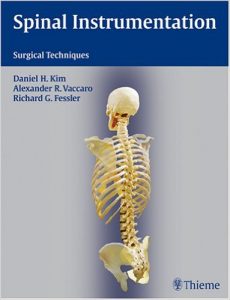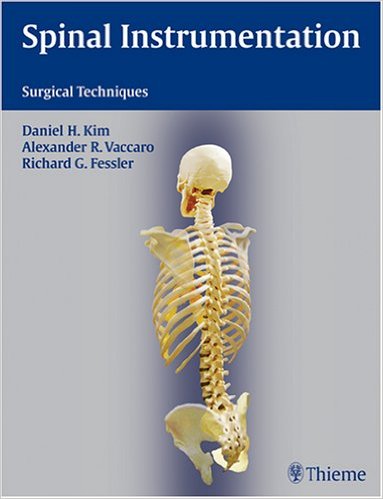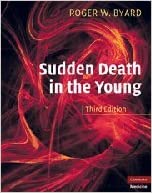 Editors: Daniel H. Kim, MD; Alexander R. Vaccaro, MD; and Richard G. Fessler, MD
Editors: Daniel H. Kim, MD; Alexander R. Vaccaro, MD; and Richard G. Fessler, MD
Publisher: Thieme – 1,330 pages
Book Review by: Nano Khilnani
The implantation of devices as part of the process of stabilization and/or reconstruction of the vertebral column is “an important advance in operative technique,” Dr. Philip Weinstein, who wrote the Foreword to this book, points out. These procedures have helped treat patients with conditions such as scoliosis (abnormal curvature of the spine) and those who have painful degenerative diseases of the spine.
It is important to note a statistic Dr. Weinstein cites: about a quarter million spinal fusions (neurosurgical and/or orthopedic procedures that join two or more vertebrae) are performed annually, at a cost of about $2 billion. That translates into an average cost of about $8,000 per procedure, not a very prohibitive amount relative to other types of surgery. This may simply be related to supply and demand. And as these types of operations continue to grow in number, are costs likely to go down? Perhaps.
This book focuses on surgical anatomy and surgical techniques involving the spine, particularly with instrumentation, unlike others that discuss mainly, anatomical or pathological diagnoses.
Two hundred fifty specialists, mainly in neurosurgery, orthopedic surgery, and spine surgery, but also in biomedical science, head trauma, peripheral nerve surgery, reconstructive surgery, rehabilitation, and allied fields, from the United States and eight other countries, wrote the 166 chapters organized around 12 sections we name below to provide you an overview of the contents of this large book:
Most of the authors are from the United States, but a number of them are from Brazil, Canada, France, Germany, Ireland, Italy, Japan, and Slovenia.
This book has extensive coverage with chapters on virtually every type of instrumentation surgery relating to the spine. We list below its sections to provide you an overview of what you will find in it:
- Section 1: Craniovertebral Junction
- Section 2: Anterior Cervical Spine
- Section 3: Posterior Cervical Spine
- Section 4: Cervicothoracic Junction
- Section 5: Anterior Thoracic and Thoracolumbar Junction
- Section 6: Posterior Thoracic and Thoracolumbar Junction
- Section 7: Anterior Lumbar Spine
- Section 8: Posterior Lumbar Spine
- Section 9: Lumbosacral Junction and Sacrum
- Section 10: Allografts / Synthetics
- Section 11: Artificial Disks
- Section 12: Miscellaneous
Since the first attempt to stabilize the spine with instrumentation was made about a hundred years ago by Lang, surgical procedures of this type have grown exponentially, writes Dr. Todd J. Albert in a second Foreword to this comprehensive work on surgical techniques to stabilize the spine with external devices or tools.
Not only has the overall number of spinal instrumentation procedures grown worldwide, so has the variety of systems used for each part of the spine, and the particular conditions or situations each system has been designed to correct. As you go through the book, you may be bewildered by the images of different devices, biomechanical hardware and tools used in the many procedures – bolts, calipers, caps, drills, heads, hooks, plates, rods, spacers, and screws.
But there is no reason to be bewildered if you calmly focus on reading and understanding a single chapter at a time, written by an experienced specialist or team of specialists. The materials in each chapter are organized in a systematic fashion with familiar components that are found in other chapters as well.
Let’s take look for example at what you will find in a typical chapter. Go to chapter 96, The Colorado System: Technique for Surgical Treatment of Adolescent Idiopathic Scoliosis, authored by Ensor Transfeldt, Amir A. Mehboob, and Pierre Rossouly found on page 701 in Section 7 entitled Anterior Lumbar Spine.
The chapter begins with a paragraph stating that the goal of surgically treating an adolescent who has idiopathic scoliosis includes:
- Appropriate correction and stabilization of the curve
- Reduction of clinical deformity
- Restoration / maintenance of a well-balanced spine in the coronal as well as sagittal plane
The authors write that a decision must be made as to correct the spine anteriorly or posteriorly. They help you make the right decision by explaining that anterior surgery is reserved for single thoracic, thoracolumbar or lumbar curves where one can save distal fusion levels.
They qualify this by writing: “with the use of pedicle screws, one may be able to fuse shorter segments obviating the need for anterior surgery. One must later decide on the specific curves and the levels to include in the fusion as well as instrumentation. This determination is based on classification schemes as well as side-bending radiographs.”
The subsequent parts of this chapter consist of the following headings:
- Instrumentation: History
- Operative Techniques of the Colorado System
- Instrumentation
- Hooks (with photos and instructions)
- Pedicle Screws (with photos and instructions)
- References
Among the key features of this book are the following:
- Coverage of many implant systems including the pedicle screw system, Caspar plate system, Reflex Anterior Cervical System, Axis Fixation System, VBR expandable cages, Harms Titanium Mesh, and many more
- Expertise and unique insights of the inventors of each system shared in every chapter
- Side-by-side comparisons of each instrumentation system, allowing for better decisions
- More than 2,000 illustrations depicting all implant systems and their applications
- Pearls and pitfalls – valuable for avoiding common technical errors and complications
- Logical organization by anatomic region and surgical approach for easy access to info
This is a comprehensive work on spine surgery with instrumentation. There are not many texts on this specific medical subject, and this one is not only authoritative with 250 expert contributors, it is also well-illustrated with clear images accompanied by detailed surgical steps.
Editors:
Daniel H. Kim, MD, FACS is Associate Professor and Director of Spinal Neurosurgery and Reconstructive Peripheral Nerve Surgery in the Department of Neurosurgery at Stanford University Medical Center in Stanford, California.
Alexander R. Vaccaro, MD, FACS is Professor of Orthopedic Surgery, and Co-Director of Spinal Cord Injury Center and Reconstructive Spine Services in the Rothman Institute at Thomas Jefferson University Hospital in Philadelphia, Pennsylvania,
Richard G. Fessler, MD, PhD is Professor and Chief of the Section of Neurosurgery in the Chicago Institute of Neurosurgery and Neuroresearch at University of Chicago Hospitals in Chicago, Illinois.







